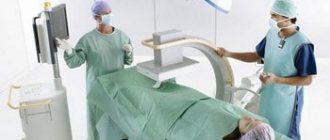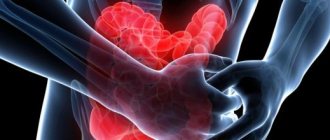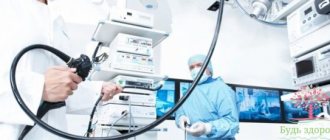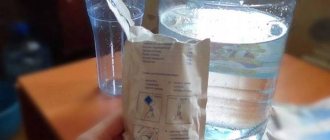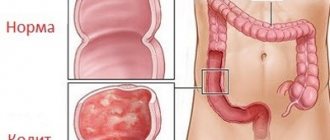It is important for a patient who has received a referral for intestinal irrigoscopy to understand what it is, how to prepare for the procedure and why it is performed. Irrigoscopy is one of the methods of X-ray examination of changes in the lumen of the large intestine. A suspension of radiopaque contrast agent (barium sulfate is most often used) is injected into the colon, after which the doctor takes an image. The contrast agent is administered using a special device through the rectum; in some cases, the radiopaque mixture is taken orally. With this method of contrast, filling of the large intestine occurs slowly; the suspension moves to the rectum within 12-15 hours. Barium sulfate is insoluble in water and is not absorbed into the blood. After the procedure, the remainder of the contrast suspension is eliminated naturally within a few days.
Monitoring the progress of the contrast agent makes it possible to determine the presence of neoplasms or foreign bodies, and that’s not all that intestinal irrigoscopy shows. The examination reveals:
- Features of the location, shape, changes in the diameter of the intestinal lumen;
- Elasticity of intestinal walls;
- Functional state of different parts of the intestine;
- Changes in the relief of mucous membranes;
- The condition of the bauginian valve (folds at the junction of the small intestine into the large intestine).
The radiation exposure to the body during irrigoscopy is less than during computed tomography; the procedure is non-traumatic, painless, and available in the vast majority of clinics. If an X-ray examination of the large intestine is necessary, this method is most often used.
When is preparation necessary?
An examination based on the use of X-rays is carried out quickly and provides detailed, high-quality information regarding the organs being examined. Considering the length of the intestine and possible contraindications, due to which it is impossible to perform a direct examination from the inside using colonoscopy, barium enema is a worthy alternative.
As a result of irrigoscopy, the doctor receives a detailed picture of the intestine with possible morphological changes, neoplasms and various inflammatory processes. It is also possible to evaluate the size of the organ lumen, the length and structure of the folds, and its motility. Intestinal irrigoscopy, due to its wide ability to detect many diseases, is one of the primary and inexpensive methods, and is prescribed if the following are present:
- pain or discomfort in the groin area or anus;
- frequent disorders of the stomach and intestines - constipation or diarrhea;
- violation of the structure of the colon, diverticulosis, fistulas;
- bleeding from the anus or various discharges (pus, mucus);
- change in the shape and length of the intestine – dolichosigmoid;
- inflammatory processes, Crohn's disease;
- suspicion of the presence of a neoplasm;
- postoperative scars or adhesions.
The structure and possible pathologies of the intestine, which are assessed during irrigoscopy
This study of the colon is also used for monitoring after intestinal resection operations, to detect oncological relapses and to assess the independence of interintestinal anastomoses. High-quality preparation is one hundred percent guarantee of obtaining accurate results! The most important aspect on which irrigoscopy is based is scrupulous and well-executed preparation for the examination.
Almost all diagnostic methods used for the large intestine are based on the same principle - ideal cleanliness of the organ. Therefore, preparatory measures for this procedure are no different from those used for colonoscopy or irriography, which also allow a detailed study of the colon. So how to prepare for intestinal irrigoscopy so that you don’t have to do it again due to the inability to obtain the necessary data?
Preparation for the examination includes two important components - maintaining a slag-free diet and the cleansing itself.
Carrying out the procedure
Before the first procedure, it is advisable to imagine how irrigoscopy is performed in order to avoid unnecessary anxiety. The procedure can last up to 45 minutes, depending on the purpose of the examination.
An aqueous suspension of barium sulfate is pre-prepared; the temperature of the suspension is about 35 degrees, so that the patient does not feel discomfort. The suspension is pumped into the intestines using a Bobrov apparatus, consisting of a hermetically sealed jar and two tubes. One of the tubes is equipped with a bulb, the second is intended for insertion into the rectum.
First, a survey of the abdominal organs is taken, after which the patient should turn over on his side, bend his legs and put his hands behind his back. A tube is inserted into the rectum and a contrast solution is gradually injected. To ensure proper distribution of the suspension, the patient periodically changes position under the guidance of a doctor. Filling of the intestine with contrast is monitored using a series of images.
As the intestine fills, several targeted and overview images are taken. When the suspension is completely distributed, another overview photo is taken. Based on a series of images, the doctor can assess the condition of the intestinal lumen.
When the tube is removed, a reflex bowel movement occurs, after which another overview image is taken, which shows the relief of the mucous membrane.
After the so-called tight one, double contrast is performed, for which air is carefully pumped into the intestine. This technique allows you to detect changes in the structure of the intestinal walls.
After irrigoscopy, the feeling of bloating in the abdomen persists for some time, and the stool is lighter than usual. As the remaining contrast agent is removed, the color of the stool evens out. Sometimes defecation delays are possible, which should be reported to the doctor. Based on the analysis of the images, the doctor will make a diagnosis and, based on this, explain what you can eat after irrigoscopy. The basis for possible restrictions is not the procedure, but the identified pathology.
Slag-free diet
It is necessary to go on a slag-free diet 2 days before the appointed date of the study, that is, you will have to exclude foods that increase the formation of fecal matter and increased gas formation.
Such food products include:
- vegetables - beets, potatoes, cabbage, carrots, tomatoes, onions, peppers, herbs;
- fruits and berries - peaches, apricots, lemons, oranges, apples, bananas;
- porridge – millet, pearl barley, oatmeal;
- legumes - beans, lentils, beans, peas;
- wholemeal bread, bran, mushrooms.
Products that promote the formation of copious fecal matter and waste
For at least 2 days before the procedure, you are allowed to eat only waste-free food that does not lead to the formation of abundant feces and increased gas formation. If the patient does not know what he can eat during the preparatory period, he should take a memo from the nurse, which describes the entire algorithm in detail. Permitted products include broths, eggs, semolina porridge, boiled lean meats or fish, fermented milk products, except cottage cheese.
All foods subject to heat treatment should be boiled or steamed. The broth should not be too rich. On the eve of the examination, you can eat only light food at lunch, for example, boiled fish, fermented milk products or semolina porridge. It is forbidden to eat solid food for dinner, so it will consist of broth, kefir or fermented baked milk, yogurt, compote. Breakfast on the day of the examination will also only be liquid.
Indications for irrigography
The irrigography procedure is not performed as a screening, unlike endoscopic examination. X-ray diagnostics are carried out only if serious diseases of the large intestine are suspected. There are a number of indications for performing irrigography. Among them:
- Suspicion of intestinal obstruction. In this case, contrast is not performed, since the introduction of barium sulfate can only worsen the situation. In addition, the substance will not be able to fill the entire intestine due to the presence of an obstruction. If there is obstruction, the study is stopped after the first stage - plain radiography.
- Suspicion of a tumor. In some cases, with oncological pathologies, complete intestinal obstruction does not occur. However, if there is a tumor in the lumen of the organ, it compresses the stool, and can also be injured and bleed during defecation. Bowel cancer can be suspected based on complaints such as weakness, weight loss, elevated body temperature to subfebrile levels, pain in the lower abdomen, and constipation. If the tumor is localized in the left half of the intestine, a pathological impurity is observed during bowel movements (blood, pus, mucus). The shape of the stool may change (in the form of ribbons).
- Suspicion of benign neoplasms – intestinal polyps.
- Nonspecific ulcerative colitis (UC) is a chronic inflammatory process in the intestine.
- Crohn's disease. It is characterized by irreversible changes in the intestine, ulceration of its walls and the appearance of granulomatous growths. UC and Crohn's disease are facultative precancerous conditions.
Purgation
To fulfill the most important condition of preparation for the procedure - to perfectly cleanse the intestines, two methods can be used, and the patient has the opportunity to choose the most acceptable one for himself. This is a familiar method for many and quite common due to its simplicity and economy.
For it you will need an Esmarch mug or a combination heating pad and slightly cool, maybe slightly salted or acidified water. The water temperature should not exceed 35–37 ºС, since warm water helps to dissolve fecal matter, which prevents its complete removal from the intestine.
Diet before irrigoscopy
On the eve of the diagnosis, at lunch you need to drink 2 tbsp. spoons of castor oil or 150 ml of a 30% solution of MgSO4 (magnesium sulfate), which will contribute to high-quality cleansing.
In the evening, after an independent act of defecation, you need to do two enemas at 20.00 and 22.00, and then in the morning at 7–8 o’clock on the day of the study, you need to repeat the enema.
Esmarch's mug must be filled with 1.5–2 liters of water. To ensure that the tip enters carefully and does not injure the anus, it should be lubricated with Vaseline or baby cream. After inserting the tip, you need to open the valve and water will begin to flow into the intestine. There is no need to apply a lot of pressure, as this can be painful for the intestines.
It will be quite difficult to carry out such a procedure yourself, so it is better to ask loved ones for help in this action. After introducing water, you need to lie down on one side, then on the other, for several minutes and repeat the procedure until the water used for rinsing becomes absolutely clean.
To cleanse using an enema, you will definitely need help - it’s difficult to clean on your own.
You can also add a decoction of herbs, such as chamomile, to ordinary water for washing the intestines. If cleaning with enemas is contraindicated (inflammatory process in the intestine, hemorrhoids), alternative methods that are safe for these diseases should be used.
What is irrigoscopy
The study makes it possible to detect intestinal pathology in a timely manner and monitor the results of treatment. It is carried out after retrograde (enema) administration of barium sulfate (contrast). Accompanied by less radiation exposure compared to computed tomography (CT).
Irrigography and endoscopy are also inferior, since they are not as accurate as the method under consideration. With its help, information is obtained about the current state of the intestine, the degree of its elasticity, the diameter of the lumen, and the relief of the mucosa. It shows areas of scarring and ulceration, as well as polyps, diverticula and tumors. The result is confirmed by a series of photographs.
By the speed of contrast movement, the doctor judges how efficient the Bauhinian valve (the fold between the ileum and colon) is. If its functions are impaired, reflux is possible (reflux of digested food in the opposite direction).
Video: Ultrasound of the intestines
Medical cleansing
Modern medicine currently offers a fairly large number of drugs with which you can perform high-quality intestinal cleansing without using enemas. Fortrans and Duphalac are considered the most common and easy-to-use products.
Fortrans
Cleaning with Fortrans, in addition to the positive aspects that ensure high-quality preparation of patients for the study, has not very pleasant aspects associated with the unpleasant taste of the diluted drug. Therefore, when using it, you can add orange or lemon juice to the solution. The drug contains ingredients that have the property of cleansing the intestines - macrogol, sodium bicarbonate, anhydrous sodium sulfate, potassium and sodium chloride.
Before purchasing the drug, you need to calculate how much it will be needed for cleansing preparation.
The amount of the substance depends on body weight, that is, you need to purchase 1 sachet per 20–25 kg of the patient’s weight. If the procedure is planned the next morning, then lunch the day before should be no later than 14:00. You should start taking the drug from 16-17 hours. To prepare the solution, dissolve 1 sachet in 1 liter of water and drink it within an hour.
If the intake is accompanied by nausea, then you can suck on a slice of lemon after the next serving. In a situation where the procedure is planned after lunch, half of the required dose of the drug should be taken the night before at 18–19 hours, and the rest in the morning at 7–9 hours.
Duphalac
The drug is available in bottles, as it is in the form of a liquid. To clean, you need to dilute the entire contents of the container - 200 ml in 2-3 liters of water and take a glass of the resulting solution every 15 minutes. The entire prepared solution should be consumed within 2–3 hours. The urge to defecate will begin approximately 1-2 hours after the first drink.
Cleansing with Duphalac is a soft and comfortable method. It is very important, if the patient is preparing for the procedure using medical means independently, to carefully read the instructions for the drug, including contraindications and possible side effects.
Preparation for intestinal irrigoscopy
The day before the procedure, the patient should completely abstain from any food. During the day, he needs to drink clean water, without gas (drinks such as juices, tea, coffee are prohibited). The amount of water you drink per day should be from 2 to 3 liters. A diet through fasting during the day is not only necessary for good visibility during the procedure, but it is also beneficial for the body as a whole.
It should also be remembered that the more responsible the patient is in preparing for irrigoscopy, the more accurate and correct the diagnosis will be made by the doctor.
Doctors' recommendations
Despite the fact that the procedure does not involve surgery or any other type of damage, the doctor should definitely take into account possible contraindications that the patient has.
Factors under which research is prohibited include:
- severe general condition of patients;
- heart failure;
- intestinal obstruction;
- ulcerative colitis, cyst;
- arterial hypertension;
- diarrhea accompanied by blood;
- suspicion of intestinal perforation.
Ulcerative colitis is one of the serious contraindications for irrigoscopy
Irrigoscopy is also contraindicated for pregnant women, nursing mothers and children, although an exception is made for breastfeeding women in certain cases. If you take into account all aspects of the examination - timely appointment, training and professionalism of the doctor, then you can obtain reliable results with 100% confidence, facilitating the rapid establishment of the correct diagnosis.
Contraindications to the procedure
X-ray contrast examination of the intestine has some contraindications. In particular, such examination is strictly contraindicated during pregnancy. Irrigoscopy is not performed if:
- The patient is in serious condition;
- With perforation of the intestinal wall.
Extreme caution is also necessary in acute inflammatory diseases such as rapid ulcerative colitis or diverticulitis. If it is necessary to examine the large intestine in such cases, another method is selected that has no contraindications.
Tips before and after the irrigoscopy procedure
The day before the study, you should not lead an active life, go somewhere for a long time from home, so as not to waste energy and not be tempted to eat something forbidden. Food should be liquid.
It is recommended to limit physical activity the day before the test.
Before the procedure, you should notify your doctor:
- exactly how the intestines were cleansed;
- about existing chronic diseases;
- about medications taken that affect blood clotting;
- about cases of bleeding from the rectum.
Before performing the procedure, the doctor must make sure there are no contraindications
Important! Draw the doctor's attention to notifying you about intestinal obstruction discovered during the examination.
After the procedure, a gradual transition to the usual diet is important so as not to harm the intestines. The first solid food should be boiled rice with butter, or liquid oatmeal. Bread should be eaten no earlier than 24 hours later. On the first day after irrigoscopy, coffee, milk, alcohol, sugar, vegetables and fruits are excluded from the menu. Meat should be eaten only on the third day.
The first food after the procedure should be rice or oatmeal with a small amount of butter
Armed with these tips, the recommendations of your doctor and common sense, you can safely hope that barium enema will be a safe, informative and health-promoting procedure for you.
Execution order
The day before the study, the doctor should explain to you in detail how irrigoscopy is performed. There is a clear algorithm for conducting a contrast examination:
- The patient's intestines must be thoroughly cleaned of feces. Preparing the patient for irrigoscopy begins several days before the procedure.
- The initial position of the patient on the X-ray table during the examination is lying on the left side, legs bent at the knees, pulled towards the stomach.
- A 2-liter volume of contrast agent is injected through the rectum slowly and carefully, under the control of an X-ray machine. If necessary, the amount of contrast is increased.
- As the contrast agent is administered, the patient is asked to change body position for better advancement of the drug (according to the anatomical bends).
If necessary, the procedure is supplemented with double contrast and/or irrigography is used.
Procedure for performing irrigoscopy
Patient reviews
Natalya: I had this procedure done 4 years ago. I followed everything the doctor said, the diet before the irrigoscopy and drank a lot of water, also drank Duphalac as a laxative and ran to the toilet for about six hours. In the morning I went to the clinic, where they put me on my side, inserted a tube, and I felt that I was being pumped with air and liquid. Then I turned around, the doctor took pictures, it didn’t hurt at all.
Vyacheslav: I underwent both colonoscopy and irrigoscopy. So there is something to compare with; irrigoscopy is indeed softer, but less informative. Before the procedure, I did not take a laxative, I chose an enema.
Olga: After the procedure, I actually went to work, since nothing hurt and there was no urge to go to the toilet. Barium then came out for a couple of days, yes, the stool was partially whitish and that’s all.
special instructions
If there is no effect from taking the drug for several days, you should consult your doctor.
Please note that Duphalac may contain small amounts of sugars (for example, lactose, galactose, fructose). When taken in dosage to treat constipation, this is not a problem for diabetic patients. But when treating hepatic coma (encephalopathy), the sugar content should be taken into account for this group of patients.
Patients with galactose or fructose intolerance should not use this drug. Duphalac for newborns can only be used under medical supervision.
Have you been prescribed an X-ray examination of the colon with a contrast agent, and are you looking for clarification about the correct preparation of the intestine for this procedure? Our consultant, surgeon Georgiy Ramishvili, tells in detail how to prepare for intestinal irrigoscopy, how the procedure is carried out, about the diet before the study, and about preparing for irrigoscopy with Duphalac, enemas and modern osmotic laxatives. So, over to the doctor.
The gastrointestinal tract is a very compactly packaged system with an average length of 8 meters. The size of the colon is 1.5 - 1.8 meters, and the area is about 2 m2. Agree that examining such a scale with a conventional endoscope, combing the wrinkled walls of the intestine millimeter by millimeter, looking under each fold, is difficult, time-consuming, and unpleasant. In addition, contrary to popular belief, the doctor is also a person and may not be able to discern minor deviations from the norm. To conduct a quick and most informative study, they resort to x-rays, which see everything “through and through.”
What diseases can affect the large intestine?
Most often, patients with problems with the large intestine find:
- ulcerative colitis;
- colon cancer and polyps;
- Crohn's disease;
- ischemic and pseudomembranous colitis;
- irritable bowel syndrome;
- wall diverticula;
- congenital anomalies.
Ulcerative colitis
Pathology is a chronic condition of an organ when its internal mucous membrane becomes swollen, inflamed, changes its color from normal beige-pink to bright red, and loses its integrity due to small ulcerative formations. These ulcers do not heal well and bleed. If the disease lasts for a long time and without adequate treatment, it can provoke the appearance of polyps and neoplasms.
Oncology, polyps, neoplasms
Tumors in the large intestine are quite common in patients. Colon cancer is generally one of the four most common types of cancer on the planet. Polyps and tumors in this part of the body are most dangerous because their appearance is practically asymptomatic, and in the early stages they can only be detected by accident. The consequences of oncological and tumor processes in the colon can be the most severe, including death.
Directions for use and doses
This drug is intended for oral administration. The syrup can be taken undiluted or diluted with water. If Duphalac is prescribed once a day, then it should be taken at the same time (for example, in the morning during breakfast).
When treating constipation and to soften stool, the drug is prescribed to adults in an initial dosage of 15-45 ml daily, and then switched to a maintenance dose of 15-30 ml. The initial dose is selected individually; the drug can be taken once or divided into 2 parts. The maintenance dose is selected depending on the response to this drug. According to reviews of Duphalac, the therapeutic effect may appear 2-3 days after starting to take the drug. During treatment with Duphalac, it is necessary to take a sufficient amount of fluid (1.5-2 liters per day).
For children, the dosage of the drug is selected depending on age:
- children 7-14 years old – 10-15 ml per day;
- children 1-6 years old 5-10 ml per day;
- children under one year old – up to 5 ml per day.
Duphalac for newborns is also used in the treatment of constipation and dysbiosis. It is recommended to start taking it with 1 ml, gradually increasing the volume of the drug to 4-5 ml (this will help avoid increased gas formation).
When treating hepatic encephalopathy, the dose of Duphalac is selected individually, usually the initial dosage is 30-45 ml.
To prepare the colon for research, 100-150 ml of the drug is used. Typically, the dosage depends on the type of study, the patient’s condition and is selected by the doctor individually. According to reviews, Duphalac for these purposes is best used in combination with other methods of intestinal cleansing (for example, cleansing enemas).
Where to go?
The study is carried out strictly as prescribed by the attending physician. He can also tell you where to undergo irrigoscopy. As a rule, such research is carried out in medical clinics on a paid basis. It can also be completed in budgetary institutions, but only if the clinic has the appropriate equipment. Information regarding the provision of services must be clarified at the reception of the selected medical institution.
Consequences and contraindications
After the procedure, white spots may appear within a few days. This is the injected substance. You should consult a doctor if you experience the following symptoms:
- Long-term painful sensations in the abdominal area that do not go away;
- Blood is released from the anus;
- Increase in body temperature;
- Dizziness and weakness appear.
The irrigoscopy procedure is not permitted for the following manifestations:
- Diarrhea with blood;
- The large intestine enlarges;
- Reactive course of ulcerative colitis;
- Heart rhythm disturbances;
- Pregnancy.
A number of doctors suggest that the exception to the procedure is for women who have not given birth. Irrigoscopy is used with caution if blood flow in the organ is impaired. Dysfunction of the large intestine leads to careful study of the use of the method.
The device used for the study is the Bobrov apparatus. It is a jar with a lid containing two tubes. One with a rubber bulb. She supplies air. On the second there is a device for supplying the solution. The method of moving the liquid substance through the colon is informative. Light areas and dark areas are visible. This indicates the condition of the organ. The basis for the result is the contrast agent. Air will help determine the thickness of the intestinal wall. The air pressure, which is created in excess, and the x-ray substance enter in turn.
A modern analogue is the UIPS-VIPS-MED device. The main advantage of the device is its simplicity.
The doctor will describe the essence of the manipulations to the patient and answer any questions.
The success of a colonoscopy examination largely depends on preliminary high-quality bowel cleansing. To prepare for a colonoscopy, along with a special diet, pharmacy laxatives are used. Moviprep has proven itself to be a reliable remedy in preparation for colonoscopy.
Methods and drugs used
The information content of the data obtained depends on how irrigoscopy is performed. Two contrast techniques have been developed: simple and double, in which, after introducing a contrast agent, X-ray negative compounds (air, carbon dioxide, nitrous oxide) are injected into the intestinal lumen. Double contrast allows a more detailed study of the relief of the intestinal mucosa, especially for tumors in the initial stage of development. Next, we will find out how irrigoscopy is done?
As a contrast agent, preparations containing barium or iodine are introduced - heavy chemical elements that absorb X-rays. Barium sulfate is an opaque white mixture. This is the main drug used in fluoroscopy of the gastrointestinal tract. Less commonly used is an iodine-containing solution, which does not irritate the abdominal membrane, but is radioactive.
Carrying out irrigoscopy
